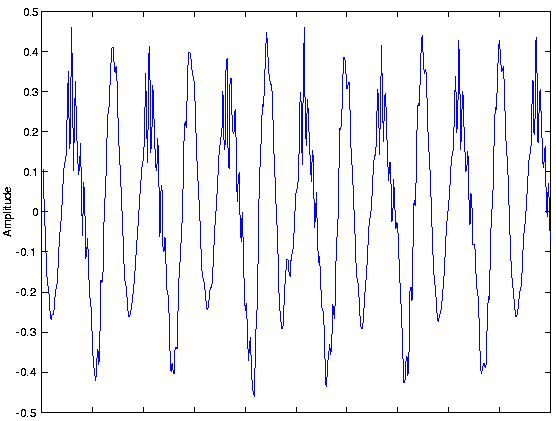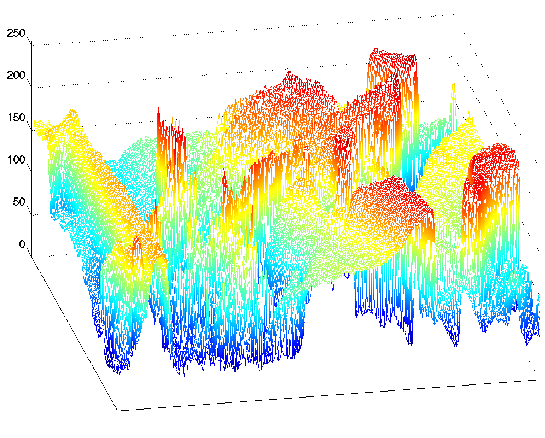Analog signals are usually signals defined over
continuous independent variable(s).
Speech
is produced by your vocal cords exciting acoustic resonances
in your vocal tract. The result is pressure waves propagating
in the air, and the speech signal thus corresponds to a
function having independent variables of space and time and a
value corresponding to air pressure:
s(x, t)
(Here we use vector notation
x
to denote spatial coordinates). When you record someone
talking, you are evaluating the speech signal at a particular
spatial location,
x0 say. An example of the resulting waveform
s(x0, t)
is shown in
this figure.
Photographs are static, and are continuous-valued signals
defined over space. Black-and-white images have only one value
at each point in space, which amounts to its optical reflection
properties. In Figure 1.2, an image is
shown, demonstrating that it (and all other images as well) are
functions of two independent spatial variables.
Color images have values that express how reflectivity depends
on the optical spectrum. Painters long ago found that mixing
together combinations of the so-called primary colors--red,
yellow and blue--can produce very realistic color images.
Thus, images today are usually thought of as having three
values at every point in space, but a different set of colors
is used: How much of red, green and blue
is present. Mathematically, color pictures are
multivalued--vector-valued--signals:
s(x)=(r(x), g(x), b(x))T.
Interesting cases abound where the analog signal depends not
on a continuous variable, such as time, but on a discrete
variable. For example, temperature readings taken every hour
have continuous--analog--values, but the signal's independent
variable is (essentially) the integers.
The word "digital" means discrete-valued and implies the signal
has an integer-valued independent variable. Digital information
includes numbers and symbols (characters typed on the keyboard,
for example). Computers rely on the digital representation of
information to manipulate and transform information. Symbols do
not have a numeric value, and each is represented by a unique
number. The ASCII character code has the upper- and lowercase
characters, the numbers, punctuation marks, and various other
symbols represented by a seven-bit integer.
For example, the ASCII code represents the letter
a as the number
97
and the letter A as
65
.
Table 1.1 shows the
international convention on associating characters with
integers.
The ASCII translation table shows how standard keyboard
characters are represented by integers. In pairs of columns, this table displays
first the so-called 7-bit code (how many characters in a seven-bit
code?), then the character the number represents. The numeric codes
are represented in hexadecimal (base-16) notation.
Mnemonic characters correspond to control characters, some of
which may be familiar (like cr for
carriage return) and some not (bel means
a "bell").
00
nul
01
soh
02
stx
03
etx
04
eot
05
enq
06
ack
07
bel
08
bs
09
ht
0A
nl
0B
vt
0C
np
0D
cr
0E
so
0F
si
10
dle
11
dc1
12
dc2
13
dc3
14
dc4
15
nak
16
syn
17
etb
18
car
19
em
1A
sub
1B
esc
1C
fs
1D
gs
1E
rs
1F
us
20
sp
21
!
22
"
23
#
24
$
25
%
26
&
27
'
28
(
29
)
2A
*
2B
+
2C
,
2D
-
2E
.
2F
/
30
0
31
1
32
2
33
3
34
4
35
5
36
6
37
7
38
8
39
9
3A
:
3B
;
3C
<
3D
=
3E
>
3F
?
40
@
41
A
42
B
43
C
44
D
45
E
46
F
47
G
48
H
49
I
4A
J
4B
K
4C
L
4D
M
4E
N
4F
0
50
P
51
Q
52
R
53
S
54
T
55
U
56
V
57
W
58
X
59
Y
5A
Z
5B
[
5C
\
5D
]
5E
^
5F
_
60
'
61
a
62
b
63
c
64
d
65
e
66
f
67
g
68
h
69
i
6A
j
6B
k
6C
l
6D
m
6E
n
6F
o
70
p
71
q
72
r
73
s
74
t
75
u
76
v
77
w
78
x
79
y
7A
z
7B
{
7C
|
7D
}
7E
~
7F
del

















